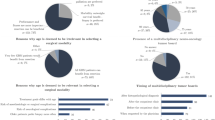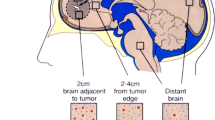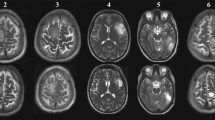Abstract
Background
Clinical decision-making involves a complex interaction between patients and caregivers. The medical knowledge and values of caregivers are essential for treatment recommendations. This study was undertaken to evaluate treatment recommendations by a group of Scandinavian neurosurgeons before and after an expert lecture on glioblastoma surgery.
Method
An interactive voting system was used to record responses to four questions regarding glioblastoma management before and after a 25-min lecture on the benefit of radical glioblastoma surgery.
Results
The majority of the audience aimed at radical surgery combined with radiotherapy before (76 %) and after (88 %) the lecture. The proportion who recommended immediate postoperative follow-up by MRI increased from 34 % to 75 %. Fourteen percent (before) and 45 % (after) recommended renewed surgery to remove small residuals in patients, while 52 % (before) and 60 % (after) would have wanted to be re-operated if they themselves had been patients.
Conclusion
The views on optimum management differed widely in a relatively homogeneous group of neurosurgeons. The lecture had a major impact on decision-making. A large proportion of the attendees recommended different management strategies for themselves and for their patients. The findings indicated the need to analyze the evaluation of medical knowledge, discuss the ethics of decision-making and encourage second opinions for serious neurosurgical decisions.




Similar content being viewed by others
References
Sackett DL, Rosenberg WC, Muir Gray JA, Haynes RB, Richardson WS (1996) Evidence based medicine: what it is and what it isn’t. BMJ 312:70–72
Bate L, Hutchinson A, Underhill J, Maskrey N (2012) How clinical decisions are made. Br J Clin Pharmacol 74:614–620
Kanu OO, Mehta A, Di C, Lin N, Bortoff K, Bigner DD, Yan H, Adamson DC (2009) Glioblastoma multiforme: a review of therapeutic agents. Expert Opin Ther Targets 13:701–718
World Value Survey (1998) In: Inglehart R, Basañez M, Moreno A (eds) Human values and beliefs—source book. University of Michigan Press, Chicago
Metcalfe SE, Grant R (2001) Biopsy versus resection for malignant glioma. Cochrane Database Syst Rev 2001(3), CD002034
Haack S (2003) Defending science—within reason. Prometheus Books, New York
British Medical Association (1995) Report of the working party on medical education. BMA, London
Marshall T (1995) Evidence based medicine. Lancet 346:1171–1172
Editorial, no authors listed (1995) Evidence based medicine; in its place. Lancet 346:785
Sackett DL (1995) Surveys of self-reported reading times of consultants in Oxford, Birmingham, Milton-Keynes, Bristol, Leicester, and Glasgow. In: Rosenberg WMC, Richardson WS, Haynes RB, Sackett DL (eds) Evidence-based medicine. Churchill Livingstone, London
Cohen AM, Hersh WR (2004) Criticisms of evidence—based medicine. Evid Based Cardiovasc Med 8:197–198
Popper K (1962) Conjectures and refutations. Routledge and Keagan Paul, London
Davidoff F, Haynes B, Sackett D, Smith R (1995) Evidence based medicine: a new joumal to help doctors identify the information they need. BMJ 310:1085–1086
Goldenberg MJ (2006) On evidence and evidence-based medicine: lessons from the philosophy of science. Soc Sci Med 62:2621–2632
Weatherall DJ (1994) The inhumanity of medicine. BMJ 309:1671–1672
Kuhn T (1996) The structure of scientific revolutions, 3rd edn. University of Chicago Press, Chicago
Popper K (1959) The logic of scientific discovery. Routledge, London
Worrall J (2007) Evidence in medicine and evidence-based medicine. Philos Compass 2/6:981–1022
Tännsjö T (2002) Understanding ethics. An introduction to moral theory. Edinburgh University Press, Edinburgh
Acknowledgment
We acknowledge the expert lecture given by Prof. Manfred Westphal, which was indispensible for our study.
Conflicts of interest
None.
Author information
Authors and Affiliations
Corresponding author
Rights and permissions
About this article
Cite this article
Mathiesen, T. To operate or not—the impact of a lecture on radical glioblastoma surgery and different treatment options on decision-making for oneself and patients. Acta Neurochir 155, 1425–1429 (2013). https://doi.org/10.1007/s00701-013-1796-8
Received:
Accepted:
Published:
Issue Date:
DOI: https://doi.org/10.1007/s00701-013-1796-8




